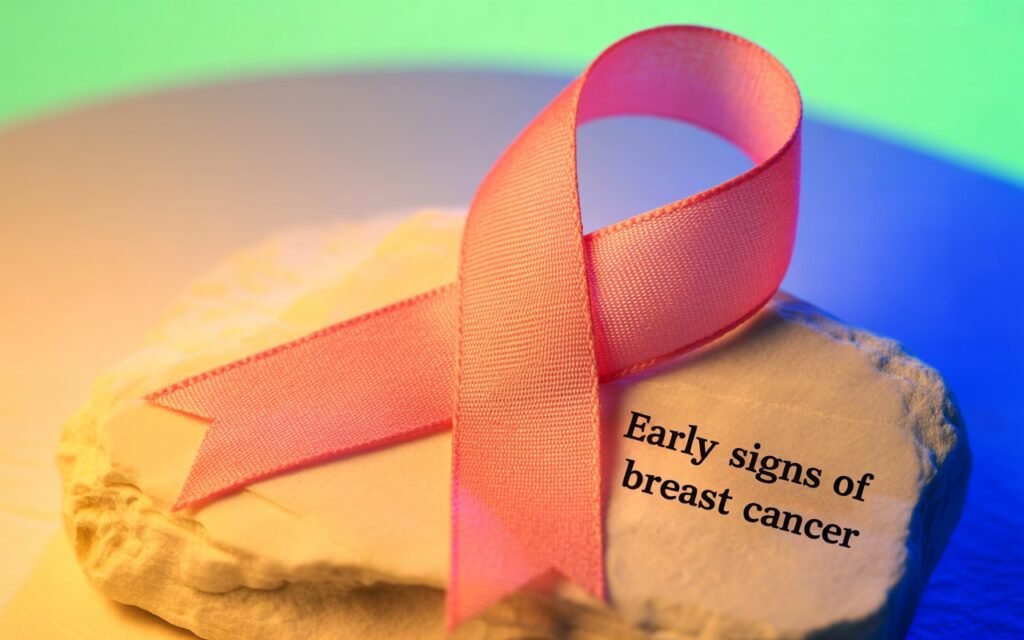Discover the early signs of breast cancer women often overlook. Learn symptoms, self-check tips, and when to see a doctor for early detection and treatment.

Introduction
Breast cancer is the most common cancer among women worldwide. Millions of lives are affected each year, yet early detection can make a dramatic difference in survival rates. The challenge is that the earliest signs are often subtle, easy to overlook, or mistaken for something harmless. Many women assume breast cancer always starts with a noticeable lump, but that’s only part of the story.
Here’s what matters: knowing the less obvious signals your body gives you. By learning to recognize these early warning signs, you give yourself the best chance at early diagnosis and effective treatment.
Why Early Detection Matters
- Survival rates: When breast cancer is found early (stage 1), the 5-year survival rate can be higher than 90%. In later stages, survival drops significantly.
- Treatment options: Early detection often means less aggressive treatments, fewer side effects, and faster recovery.
- Peace of mind: Recognizing changes quickly empowers women to seek help before problems escalate.
Bottom line: catching breast cancer early can save your life.
Common Myth: “It’s Always a Lump”
The biggest misconception is that breast cancer always shows up as a firm lump. While lumps are important to notice, many early signs are skin-deep changes or even systemic symptoms. Women often miss them because they don’t hurt or seem minor.
Early Signs of Breast Cancer Women Often Overlook
1. Changes in Breast Shape or Size
One breast suddenly appearing fuller, smaller, or differently shaped—even slightly—can signal underlying changes. If the difference appears without weight gain, pregnancy, or breastfeeding, it deserves attention.
2. Unexplained Breast Pain or Tenderness
Not all breast pain is linked to menstrual cycles or hormonal shifts. Persistent pain in one spot that doesn’t go away over weeks could be an early warning sign.
3. Nipple Changes
- Inversion: A nipple that suddenly turns inward when it was previously outward.
- Discharge: Clear, bloody, or unusual nipple discharge when not breastfeeding.
- Scaling or redness: Persistent irritation or eczema-like symptoms around the nipple.
4. Skin Changes on the Breast
Skin can reveal cancer before deeper tissues do. Warning signs include:
- Dimpling or puckering (like an orange peel).
- Unusual redness or rash that doesn’t heal.
- Thickening of skin in localized areas.
5. Swelling in the Armpit or Collarbone Area
Breast cancer often spreads first to nearby lymph nodes. Swelling, tenderness, or a lump under the arm or near the collarbone can be an early indicator—even before changes in the breast itself.
6. Persistent Itching Around the Breast
Itching that doesn’t improve with creams or lasts longer than a couple of weeks may point to inflammatory breast cancer. Many women misinterpret this as a skin allergy.
7. Visible Veins on the Breast
If new veins suddenly appear and grow larger across the breast, it may indicate increased blood flow caused by a growing tumor.
8. Changes in Breast Texture
Some women describe the skin becoming thicker, warmer, or having a “pebbled” feel. This can be mistaken for infection but may signal underlying cancer.
Risk Factors That Increase the Need for Vigilance
Not every woman with these signs has breast cancer, but risk level matters. Those at higher risk should be extra proactive:
- Family history of breast or ovarian cancer.
- BRCA1 or BRCA2 gene mutations.
- Starting periods early or reaching menopause late.
- Never having children, or having them after age 30.
- Lifestyle risks: obesity, alcohol use, smoking, or lack of physical activity.
When to See a Doctor
Here’s the rule: if you notice a change that persists for more than two weeks, don’t ignore it. Schedule an appointment with your healthcare provider. They may suggest:
- Clinical breast exam.
- Mammogram.
- Ultrasound.
- Biopsy (if needed).
It’s always better to rule out cancer than to wait.
Breast Self-Examination: Your First Line of Defense
How to Check at Home
- Look in the mirror: Check both breasts for symmetry, skin changes, or swelling.
- Raise your arms: Look for dimpling or changes under the breast.
- Feel lying down: Use the pads of your fingers to press in circular motions, covering the entire breast and armpit.
- Check while standing or in the shower: Wet, soapy skin can make lumps easier to feel.
Make it a monthly habit, preferably a few days after your period ends when breasts are less tender.
Lifestyle Tips for Lowering Risk
While not all cases are preventable, healthy habits reduce your chances:
- Maintain a healthy weight.
- Exercise at least 30 minutes daily.
- Limit alcohol intake.
- Eat a balanced diet with plenty of fruits, vegetables, and fiber.
- Breastfeed if possible—it reduces lifetime risk.
- Don’t skip regular screenings recommended for your age.
FAQs: People Also Ask
Q1: Can breast cancer be painless?
Yes. Many early cases cause no pain. This is why women often miss it until it advances.
Q2: What age should women start checking for breast cancer signs?
Self-exams can begin in the early 20s. Mammograms are usually recommended starting at 40, earlier if there’s family history.
Q3: Do all breast lumps mean cancer?
No. Most are benign (like cysts or fibroadenomas), but every new lump should be checked by a doctor.
Q4: Can lifestyle changes really prevent breast cancer?
They can’t eliminate risk completely, but healthy choices—like exercise and limited alcohol—reduce your chances.
Q5: Should men worry about breast cancer?
Yes, though rare, men can develop breast cancer. Awareness matters for everyone.
Conclusion
Breast cancer doesn’t always announce itself with a dramatic lump. The early signs can be quiet—subtle shifts in skin, texture, or sensation. These are easy to miss, but they matter. The more aware women are of these hidden symptoms, the better their chances of catching cancer when it’s most treatable.
Your body often whispers before it screams. Listen to it. Notice the small changes. And if something feels off, don’t wait—get it checked.


Pingback: Nausea Medication: The Best Ways to Find Relief-2025